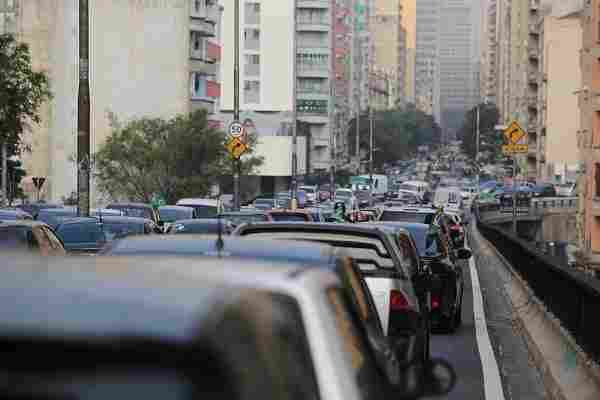September 07,2022
São Paulo's Clogged Major Highway Becomes a Pedestrian Wonderland
by David Stewart
From the verdant Parisian Promenade Plantée to MVRDV’s luminescent, Blade Runner -esque Skygarden in Seoul , elevated-park walkways have become a staple of mindful urban living in recent years. Giving a second life to obsolete infrastructure, these overgrown wonderlands are a cunning answer to their less-charming forebears, elevated highways.
Yet there’s one member of the family bridging that divide: São Paulo’s two-mile-long Minhocão, or "Big Worm." Serving as a superspeed conduit to the city for commuters during business hours, the Minhocão transforms into a pedestrian’s paradise in the evenings and on the weekends. After hours, honking horns and revving engines are swapped for bike bells and rollerblades; lanes of leaking diesel and bumper-to-bumper road rage become sites for pop-up picnics, yoga classes, and nervous first dates.
But it’s not a totally seamless marriage between worlds. What sounds like a savvy and time-sensitive retort to the grim and monotonous state of most infrastructure space is considered a scar upon the face of the Brazilian capital by others. For however dainty it becomes after dark, the Minhocão funnels more than 70,000 vehicles through the city as its day job. Installed in 1971 during the military dictatorship—one of the darkest periods of Brazil’s modern history—the hulking concrete overpass all but wiped out the city’s historic center and iconic São João Avenue. Dissidents of the so-called “battle of the Minhocão” consider the highway a living relic of the total ban on free speech and voiceless destruction of a community at the hands of the dictatorship. Unconvinced by its green-fingered façade, they argue that it simply must go.

São Paulo's Minhocão highway is infamous for its bad traffic.
For those who believe the Minhocão has turned over a new leaf with its car-free initiative, the push is for a totally “deactivated” highway—following the footsteps of New York and Seoul, among others. São Paulo’s newly elected Mayor João Doria is chipping away at the Minhocão’s automobile tolerance, as part of his larger efforts to rebrand São Paulo as South America’s first “smart city”: More than 185 miles of bike lanes now skirt the highway’s four lanes, with even more on the way. When the Minhocão fully divorces its infrastructural origins, it will play host to a plethora of restaurants, museums, and event spaces, as well as a beach and pool (no doubt inspired by the mayor’s pre-political days as a luxury retreat organizer).
Having ratified the Paris climate accord in 2016, Brazil bit the bullet by pledging to become the first major developing country to put forward an absolute emissions reduction goal by 2025—but recent rollbacks of its regulations this June suggest the country is attempting to wriggle free from its word. The fate of the controversial Minhocão could yet be the straw that breaks or rebuilds the camel’s back.






